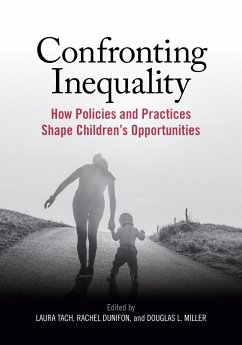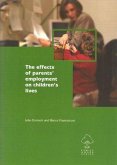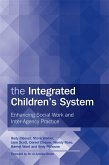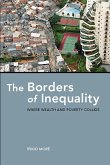Confronting Inequality
How Policies and Practices Shape Children's Opportunities
Herausgeber: Tach, Laura; Miller, Douglas; Dunifon, Rachel
Schade – dieser Artikel ist leider ausverkauft. Sobald wir wissen, ob und wann der Artikel wieder verfügbar ist, informieren wir Sie an dieser Stelle.
Confronting Inequality
How Policies and Practices Shape Children's Opportunities
Herausgeber: Tach, Laura; Miller, Douglas; Dunifon, Rachel
- Broschiertes Buch
- Merkliste
- Auf die Merkliste
- Bewerten Bewerten
- Teilen
- Produkt teilen
- Produkterinnerung
- Produkterinnerung
This book examines the impact of inequality on children’s health and education, and offers tools to help practitioners address that impact across economic, sociological, and psychological domains.
Andere Kunden interessierten sich auch für
![The Heart of the Matter The Heart of the Matter]() David BakhurstThe Heart of the Matter36,99 €
David BakhurstThe Heart of the Matter36,99 €![After the Orphanage After the Orphanage]() Suellen MurrayAfter the Orphanage31,99 €
Suellen MurrayAfter the Orphanage31,99 €![The Effects of Parents' Employment on Children's Lives The Effects of Parents' Employment on Children's Lives]() John F ErmischThe Effects of Parents' Employment on Children's Lives31,99 €
John F ErmischThe Effects of Parents' Employment on Children's Lives31,99 €![Meeting the Challenges and Opportunities of China's Rise Meeting the Challenges and Opportunities of China's Rise]() Bates GillMeeting the Challenges and Opportunities of China's Rise57,99 €
Bates GillMeeting the Challenges and Opportunities of China's Rise57,99 €![The Integrated Children's System The Integrated Children's System]() Hedy CleaverThe Integrated Children's System70,99 €
Hedy CleaverThe Integrated Children's System70,99 €![The Borders of Inequality The Borders of Inequality]() Íñigo MoréThe Borders of Inequality33,99 €
Íñigo MoréThe Borders of Inequality33,99 €![CONFRONTING CIVIL WAR IN AFRICA CONFRONTING CIVIL WAR IN AFRICA]() Luka Biong Deng KuolCONFRONTING CIVIL WAR IN AFRICA55,99 €
Luka Biong Deng KuolCONFRONTING CIVIL WAR IN AFRICA55,99 €-
This book examines the impact of inequality on children’s health and education, and offers tools to help practitioners address that impact across economic, sociological, and psychological domains.
Produktdetails
- Produktdetails
- Verlag: American Psychological Association (APA)
- Seitenzahl: 260
- Erscheinungstermin: 12. Mai 2020
- Englisch
- Abmessung: 254mm x 178mm x 10mm
- Gewicht: 454g
- ISBN-13: 9781433832666
- ISBN-10: 1433832666
- Artikelnr.: 58016305
- Herstellerkennzeichnung
- Libri GmbH
- Europaallee 1
- 36244 Bad Hersfeld
- gpsr@libri.de
- Verlag: American Psychological Association (APA)
- Seitenzahl: 260
- Erscheinungstermin: 12. Mai 2020
- Englisch
- Abmessung: 254mm x 178mm x 10mm
- Gewicht: 454g
- ISBN-13: 9781433832666
- ISBN-10: 1433832666
- Artikelnr.: 58016305
- Herstellerkennzeichnung
- Libri GmbH
- Europaallee 1
- 36244 Bad Hersfeld
- gpsr@libri.de
Laura Tach, PhD, is an Associate Professor of Policy Analysis and Management and Sociology (by courtesy) at Cornell University. Her research and teaching interests focus on poverty and social policy. She co-directs Cornell Project 2Gen, an initiative of the Bronfenbrenner Center for Translational Research that serves as a hub for research, policy, and practice that supports vulnerable caregivers and children together. Prior to joining the Department of Policy Analysis and Management at Cornell, Laura was a Robert Wood Johnson Foundation Postdoctoral Scholar at the University of Pennsylvania. Visit https://www.human.cornell.edu/people/lmt88. Rachel Dunifon, PhD is Interim Dean of the College of Human Ecology and Professor in the Department of Policy Analysis and Management at Cornell University. Prior to joining Cornell as a faculty member in 2001 she was the recipient of an NIH-funded postdoctoral fellowship at the University of Michigan. Dunifon’s research focuses on child and family policy, examining the ways in which policies, programs and family settings influence the development of less-advantaged children. Dunifon is co-director of Project 2GEN, which combines research, policy, and practice to address the needs of vulnerable children and their parents together. Visit https://www.human.cornell.edu/people/red26 Douglas L. Miller, PhD is Associate Chair and Professor of Policy Analysis and Management at Cornell University. His research interests include applied econometrics, and social policy, with an emphasis on demographically and economically vulnerable populations as well as the relationship between the economic environment and health outcomes. Prior to joining the Department of Policy Analysis and Management, he was a member of the Economics Department at UC Davis. Visit https://www.human.cornell.edu/people/dlm336
Contributors
Introduction. What Does it Take to Improve Equality of Opportunity for
Children?
Part 1. Health
Chapter 1. Reducing Stress Disparities: Pathways to Equity through the
Study of Stress Biology
Chapter 2. Does the WIC Program Promote Equality of Opportunity in Early
Life?
Chapter 3. How Do Early Life Health Experiences Affect Future Generations’
Equality of Opportunity?
Part 2. Family
Chapter 4. Behavioral Insights and Parental Decision-Making
Chapter 5. ‘Whatever They Need’: Helping Poor Children through In-Kind
Support
Part 3. Neighborhoods & Schools
Chapter 6. Promoting Equality of Opportunity by Investing Early:
Recommendations for Longitudinal Research
Chapter 7. Does School Spending Matter? The New Literature on an Old
Question
Chapter 8. How Parents and Children Adapt to New Neighborhoods:
Considerations for Future Housing Mobility Programs
Part 4. Multidisciplinary Commentary
Chapter 9: Core Concepts from the Bioecological Model of Human Development
Chapter 10: Education and Equality of Opportunity
Chapter 11: Multigenerational Influences on Child Development
Conclusion
Introduction. What Does it Take to Improve Equality of Opportunity for
Children?
Part 1. Health
Chapter 1. Reducing Stress Disparities: Pathways to Equity through the
Study of Stress Biology
Chapter 2. Does the WIC Program Promote Equality of Opportunity in Early
Life?
Chapter 3. How Do Early Life Health Experiences Affect Future Generations’
Equality of Opportunity?
Part 2. Family
Chapter 4. Behavioral Insights and Parental Decision-Making
Chapter 5. ‘Whatever They Need’: Helping Poor Children through In-Kind
Support
Part 3. Neighborhoods & Schools
Chapter 6. Promoting Equality of Opportunity by Investing Early:
Recommendations for Longitudinal Research
Chapter 7. Does School Spending Matter? The New Literature on an Old
Question
Chapter 8. How Parents and Children Adapt to New Neighborhoods:
Considerations for Future Housing Mobility Programs
Part 4. Multidisciplinary Commentary
Chapter 9: Core Concepts from the Bioecological Model of Human Development
Chapter 10: Education and Equality of Opportunity
Chapter 11: Multigenerational Influences on Child Development
Conclusion
Contributors
Introduction. What Does it Take to Improve Equality of Opportunity for
Children?
Part 1. Health
Chapter 1. Reducing Stress Disparities: Pathways to Equity through the
Study of Stress Biology
Chapter 2. Does the WIC Program Promote Equality of Opportunity in Early
Life?
Chapter 3. How Do Early Life Health Experiences Affect Future Generations’
Equality of Opportunity?
Part 2. Family
Chapter 4. Behavioral Insights and Parental Decision-Making
Chapter 5. ‘Whatever They Need’: Helping Poor Children through In-Kind
Support
Part 3. Neighborhoods & Schools
Chapter 6. Promoting Equality of Opportunity by Investing Early:
Recommendations for Longitudinal Research
Chapter 7. Does School Spending Matter? The New Literature on an Old
Question
Chapter 8. How Parents and Children Adapt to New Neighborhoods:
Considerations for Future Housing Mobility Programs
Part 4. Multidisciplinary Commentary
Chapter 9: Core Concepts from the Bioecological Model of Human Development
Chapter 10: Education and Equality of Opportunity
Chapter 11: Multigenerational Influences on Child Development
Conclusion
Introduction. What Does it Take to Improve Equality of Opportunity for
Children?
Part 1. Health
Chapter 1. Reducing Stress Disparities: Pathways to Equity through the
Study of Stress Biology
Chapter 2. Does the WIC Program Promote Equality of Opportunity in Early
Life?
Chapter 3. How Do Early Life Health Experiences Affect Future Generations’
Equality of Opportunity?
Part 2. Family
Chapter 4. Behavioral Insights and Parental Decision-Making
Chapter 5. ‘Whatever They Need’: Helping Poor Children through In-Kind
Support
Part 3. Neighborhoods & Schools
Chapter 6. Promoting Equality of Opportunity by Investing Early:
Recommendations for Longitudinal Research
Chapter 7. Does School Spending Matter? The New Literature on an Old
Question
Chapter 8. How Parents and Children Adapt to New Neighborhoods:
Considerations for Future Housing Mobility Programs
Part 4. Multidisciplinary Commentary
Chapter 9: Core Concepts from the Bioecological Model of Human Development
Chapter 10: Education and Equality of Opportunity
Chapter 11: Multigenerational Influences on Child Development
Conclusion








